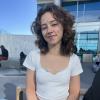I’ve been on trips with my biology classes back in the US before; last semester, I’d travel with my Marine Organisms class to the Maine coast to collect samples and observe various ecological phenomena every few weeks, so when my Mediterranean Ecosystems professor here in Spain told us we’d be going on a 2-day excursion to the field, I wrote it off as just another “outside-of-class-learning-experience.” Big mistake. Little did I know that in a few days’ time, I’d be climbing steep walls of magma, getting stuck in a wandering goat herd, swimming in the Mediterranean at midnight, and standing in the middle of a volcanic crater. Without a doubt, our trip to Spain’s largest coastal protected area, Cabo de Gata, was an experience not soon forgotten.
On our way southward, we made a few detours to observe the changing landscapes of southern Spain. After a long and winding bus ride on some (admittedly sketchy-looking) back roads, we arrived at our first stop. From this vantage point, we were able to look out over the valleys and plateaus that characterize this area. We learned about several adaptations of plants and trees in Mediterranean-type ecosystems that allow them to live and thrive in such a hot and dry climate.

Our professor explains how the land has come to take this form – over time, erosion due to water movement and glacial melting causes this beautiful and variable landscape.

Representing Bowdoin next to this amazing landscape.
Next, we headed for the coast. Having grown up on eastern shores, I’ve never seen such a dramatic coastline with jagged cliffs and deep drop-offs. I immediately fell in love with the amazing turquoise water and intense coastal beauty.

The class on the shores of the Mediterranean!
After visiting the shore, we headed up to get an aerial view of the coast.

View towards the East.
We next headed into the picturesque mountains just North of the shore.

Path to the mountains; ¡vamanos!

Ran into these guys along the way.

Winding road up into the mountains.
Once we got to the top, the view of the shore was incredible.

The view ended up being worth the long climb!

Looking out over the Mediterranean.

Titanic…? Happy to be at the top!
After returning to the bus, we drove to our hostel, where we stayed the night in a sleepy little beach town. The next morning, we headed out early to an old volcano crater to observe the kinds of succession that had taken place here many years ago after the disturbance caused by the explosion.

Inside the volcano crater!
The inside of this crater was also full of garnets, tiny gems that have a deep red color. They were scattered all over the ground, and added a reddish tint to the soil.
All in all, this was the most incredible biology field trip I’ve ever been on. This week, IES is taking us on a trip to the mystical and wifi-less land of Morocco, so stay tuned for more stories and adventures!
Hallie

Hallie Bates
<p><span style="color: rgb(29, 29, 29); font-family: Arial, Verdana, sans-serif; font-size: 12px; line-height: normal; background-color: rgb(237, 237, 237);">My name is Hallie Bates, and I'm currently a junior at Bowdoin College in beautiful Brunswick, Maine. I'm an Anthropology major, Spanish minor, and am also pursuing a pre-health track in order to one day attend medical school. I love to run, and can't wait to explore the trails in Granada and the surrounding Sierra Nevada mountains. I'm excited to get to know a new city from the inside out, and want to visit as many quirky coffee shops as possible, immersing myself in Spanish language, culture and cuisine.</span></p>






